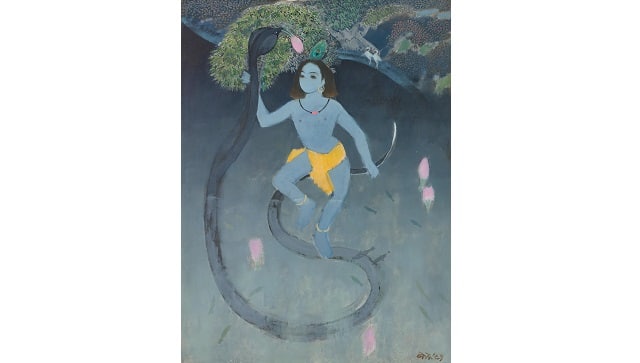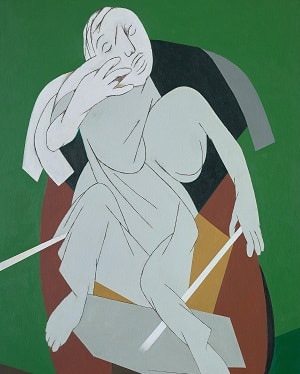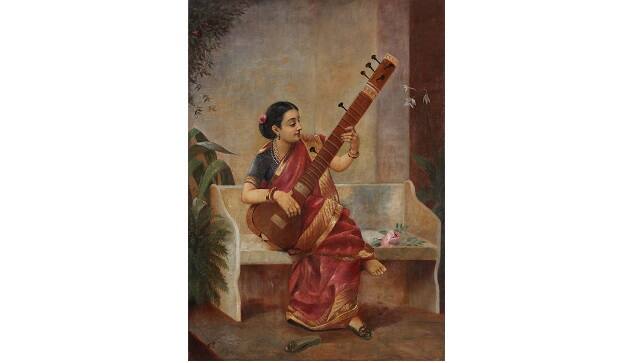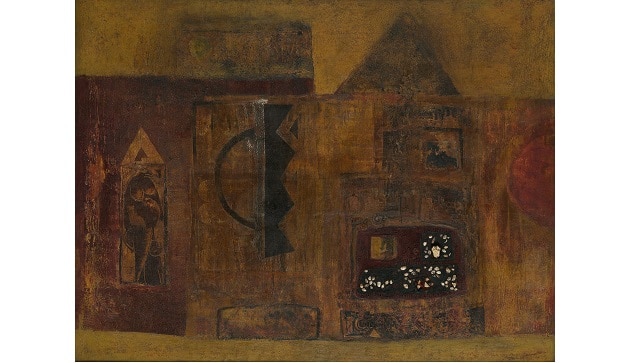Against the backdrop of the lockdown which was implemented in 2020 when COVID-19 struck India like lightening, the art market, amongst other sectors, was plunged in an asphyxiating gloom.
But despite being caught in a quagmire, India’s leading online and live auctioneer of artworks, Saffronart, decided to go with two auctions weekly. With everyone locked up in their homes, it was a conscious decision to keep people engaged.
“During the lockdown, disposable incomes of the high-end groups and businessmen had grown because they weren’t travelling, partying or attending weddings. The building up of the collectors culture had begun from 2009 after the economic meltdown in 2008. Speculators disappeared, and serious collectors gained ground. That’s been crystallising for quite a while over the last over a decade,” drives home Dinesh Vazirani, CEO, Saffronart.
[caption id=“attachment_10262861” align=“alignnone” width=“640”]
 NS Bendre, Untitled (Krishna on Kaliya), 1991
Oil on canvas, 48 x 36 in
Sold for INR 1.98 crores (USD 275,000)[/caption]
Museums, like the Kiran Nadar Museum of Art, Delhi, have begun to pick up works. They are the biggest buyer as far as art museums in India go. And they zero in on the cream of art. Besides, art buyers have become more discerning, because they are armed with increasing information, which enables them to demarcate between quality art and lesser pieces of artworks. The collectors fraternity was predominantly going for Modern Art, like the MF Husains, Tyeb Mehtas, Gaitondes, Akbar Padamsees, and Jehangir Sabavalas, to sample a clutch of such top-notch painters, while the younger collectors were focusing on the Contemporary artists. Auction sales were largely revolving around the Modernists.
“The growth of the die-hard collector brought gravitas to the market. It infuses strength in the art market. And the collectors culture is, undoubtedly, here to stay. Collectors buy artworks to live with them and soak in the ambience that they exude in their homes. If one were to quantify, today, 80 percent of those participating in auctions are unshakable collectors, while the rest could be dealers and speculators,” underscores Dinesh. “The art market is swamped by collectors.”
[caption id=“attachment_10262881” align=“alignnone” width=“300”]
 Tyeb Mehta, Rickshaw Puller, 2002
Acrylic on canvas, 59 x 35.5 in
Sold for INR 20.6 crores (USD 2.86 million)[/caption]
The assessment at Saffronart was that those drawn toward art would be keen to learn more about this sphere. The auctioneer photographed all their paintings, moved them out of the auction house’s warehouses, and went with two auctions every week ever since the lockdown. And one found that the level of engagement was simply incredible. Since everyone was confined, their homes loomed over all other locales. Consequently, they were left with a tremendous stretch of time to research into art.
“Our experience was that the art market just exploded. In fact, in the last year-and-a-half, every artist of renown broke world records like never before. Another aspect is that as the collectors community consolidated, works bought by museums like the Kiran Nadar Museum of Art never returned to the market. They were naturally for keepsake to be displayed for viewers. As a result, supply of masterly paintings has become very scant. In step, demand for masterworks has been gaining momentum, thus triggering spiralling prices of quality artworks based on basic economics,” stresses Vazirani.
[caption id=“attachment_10262831” align=“alignnone” width=“640”]
 Jehangir Sabavala, Untitled, 1991
Oil on canvas, 23.5 x 59.75 in
Sold for INR 4.86 crores (USD 662,400)[/caption]
So if the art market is gauged today, we have witnessed one of the strongest years in the last decade, from Vazirani’s standpoint. And it is not just auctions which are outperforming. Galleries have been selling very actively. The art market is truly vibrant. The big dilemma which the art buyer faces today is stumbling upon a supply of great paintings. The only way out is to sift through auctions to pick up masterworks or acquire them privately at top prices. With increasing research, art collectors have not only developed an extremely searching eye, they have become aware of the period when a master artist had produced the pick of their works. They can distinguish the upper crust of an artist’s creative output. So they became arbiters of what they felt was the top end of the market, and these are the set of paintings that collectors are keen to add to their art repositories.
“Artists who are grabbing the show are the old and the Modern masters. So it sweeps across Raja Ravi Verma, Amrita Sher-Gil, MF Husain, Tyeb Mehta, Gaitonde, Syed Haider Raza, Swaminathan, Francis Newton Souza, Akbar Padamsee to come up with a handful. The world record set by VS Gaitonde was achieved at Christie’s five to six years back. In the last six to seven months, that record has been crossed at the Pundole auction, which was again been outstripped by Saffronart scaling a level of Rs 40 crore,” says Vazirani excitedly. “Again, a step behind Gaitonde was a Amrita Sher-Gil painting, which we sold at Rs 38 crore. Rare works of the famous old masters like Raja Ravi Verma, Nandalal Bose, and Rabindranath Tagore are also performing exceptionally on the auction front,” underlines Vazirani.
[caption id=“attachment_10262851” align=“alignnone” width=“640”]
 Raja Ravi Varma, Music Hath Charms (Kadambari), Circa 1900s
Oil on canvas, 27.5 x 19.5 in
Sold for INR 20.4 crores (USD 2.73 million)[/caption]
The section of the market which is still weak is the Contemporary Art market, from his viewpoint. They have not reached the peak touched by them in 2007. Even now, they are still “hard-pressed to be half the levels that they were hovering at in 2007, if at all.” So that was 14 years ago, which is a long while. They are “underperforming” now. The flip-side is these price tags lend an opportunity to buy such artworks. Vazirani feels this segment of the market will probably perk up once the Modern masters go beyond the price point where collectors can afford them. That is the juncture when buyers will head for the next level. “Remember, the top-notch Modern masters were also Contemporary at one time. They rose to the bracket of Modernists over time,” he points out.
A development which is enthusing is that a section of individuals are contemplating opening museums or those who have actually got down to founding them. Once that fructifies, one will witness public museums joining the collectors population, and acquiring art to display them publicly, which would, in turn, instill a drive among art enthusiasts and buffs to purchase artworks.
“China has witnessed numerous private museums taking shape. So that’s going to definitely permeate in India,” opines Vazrani.
Big corporates have also turning their focus on art acquisitions. They seem to be beginning to develop the view that artworks are a worthwhile way of filling up the open spaces and interiors within their complexes. “For instance, I quite clearly fathom that corporate houses are lapping up paintings from Saffronart. After all, these bidders are registered with us. These larger companies purchase artworks for their headquarters and workstations. This class of buyers are zeroing in on a combination of Modern and Contemporary Art. Instead of buying a $4 million Gaitonde, they are homing in on a whole range of Contemporary artists. The format of instalation art by the Contemporary artists are also synergetic with the corporate culture,” observes Vazirani. “These corporates have begun realising that art is a fundamental extension of their environment.”
The seasoned art collectors are spending a whole time at home. So they would like the walls in their homes embellished with art pieces. “Now, they desire a rich environment. There is a complete mindset shift. In my view, the art market is just beginning to take off. If one looks at overseas auctions, you find one master after another breaking records, and crossing a $100 million. These Western masters include the Vincent Van Goghs, Pablo Picassos, Alberto Giacometti, Mark Rothko. Recently, a small Frida Kahlo work went for $38-39 million. People are wanting a slice of this culture at any price, which wasn’t so pronounced earlier. And supplies of these artists are diminishing fast,” informs Vazirani.
[caption id=“attachment_10262871” align=“alignnone” width=“640”]
 Jagdish Swaminathan, Untitled, Circa 1960s
Oil on canvas, 52.25 x 69.25 in
Sold for INR 2.4 crores (USD 322,148)[/caption]
The speculators market between, for instance, 2004 and 2007, has largely vanished, and one has returned to the scenario of the ’60s and ’70s, when collectors patronised art. “The art market is poised to climb further, and the burgeoning growth might surprise us. The art market in India and the subcontinent, in some ways, is bigger sometimes than the overseas market,” observes Vazirani.
That is because wealth creation in India has been quite phenomenal over the years. One witnesses a whole gamut of startups and old businesses setting fresh benchmarks in generating wealth. There is a major thrust to spin out larger revenues and profits by business houses. “So naturally, a fair quantum of these funds is projected to be channeled into art,” exults Vazirani. Saffronart’s helmsman envisages the canvas to bloom with variegated hues.
Ashoke Nag is a veteran writer on art and culture with a special interest in legendary filmmaker Satyajit Ray.
All images courtesy Saffronart


)
)
)
)
)
)
)
)
)



